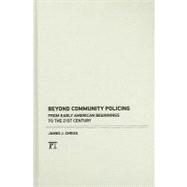
Note: Supplemental materials are not guaranteed with Rental or Used book purchases.
Purchase Benefits
What is included with this book?
| List of Tables and Figures | p. viii |
| Acknowledgments | p. ix |
| Permissions | p. xi |
| Explaining the Police | p. 1 |
| The Anomaly of the Police | p. 3 |
| Sociology and Criminology | p. 4 |
| Some Conceptual Issues | p. 6 |
| The Trials and Tribulations of Police Authority | p. 11 |
| Bittner's Principle | p. 16 |
| An Overview of the Book | p. 18 |
| Three Eras of Policing | p. 25 |
| Early Policing in London | p. 26 |
| The American Situation | p. 28 |
| Political Spoils | p. 29 |
| Reform and Early Professionalization | p. 31 |
| Community Policing | p. 36 |
| Conclusion | p. 46 |
| Policing in the Wild West | p. 49 |
| The Concept of the Frontier | p. 52 |
| Lewis and Clark, and Beyond | p. 54 |
| Growing Populations, Army Intervention, and Territorial Policing | p. 55 |
| Frontier Towns, Instability, and Lawlessness | p. 58 |
| The Code of the West | p. 60 |
| The Case of Wichita, Kansas | p. 63 |
| Conclusion | p. 65 |
| Integrity Testing and the Decision to Arrest | p. 69 |
| Why Integrity Testing? | p. 71 |
| Examples of Integrity Tests | p. 73 |
| Ethics of Integrity Testing | p. 74 |
| The Decision to Arrest | p. 76 |
| Conclusion | p. 84 |
| Post 9-11 Policing: A Functional Analysis | p. 87 |
| An Overview of Findings and Recommendations | p. 88 |
| Community Policing and Beyond | p. 89 |
| A Look at the New Paradigm of Policing: The Post 9-11 Model | p. 90 |
| Institutionalism versus Functionalism | p. 92 |
| Introducing Parsons' AGIL Schema | p. 95 |
| Cybernetics and the Criminal Justice System | p. 99 |
| The Post 9-11 Model in Relation to Police Functions | p. 103 |
| Implementing Post 9-11 Policing | p. 107 |
| Conclusion: Where Do We Go from Here? | p. 110 |
| Elements of Police Discretion | p. 115 |
| Factors in the Production of Discretion | p. 117 |
| Increased Discretion with Role Diversity | p. 120 |
| Decision Points in Police Discretion | p. 121 |
| Eleven Working Rules for Police | p. 123 |
| Can or Should Discretion Be Controlled? | p. 130 |
| The Concept of Proactivity: From Indirect Conation to Modern Municipal Policing | p. 135 |
| Preliminaries: The Beginnings of Proactivity | p. 135 |
| True Beginnings: Lester F. Ward and Conation | p. 137 |
| Ogburn and the Project of Social Prediction | p. 140 |
| Proactivity in the 1950s and 1960s: Small Group and Communications Research | p. 142 |
| Meso- and Macro-Levels | p. 143 |
| Proactivity and Public Health | p. 144 |
| Proactive Policing: A Beginning | p. 146 |
| Negative and Positive Police Proactivity | p. 148 |
| Summary and Conclusion | p. 150 |
| Police as Contact Men and Women | p. 155 |
| The Horizons of Patrol Work | p. 155 |
| The Emergence of Professional Policing in America | p. 157 |
| Police and Technology | p. 159 |
| Boundary-Spanning Structures and Activities in the Police Organization | p. 160 |
| Hirsch's Idea of the ôContact Manö | p. 162 |
| The Contact Man within Modern Police Organizations | p. 163 |
| Communities and Networks | p. 165 |
| Police as Contact Persons within the Community | p. 167 |
| Conclusion | p. 169 |
| Security and Private Policing | p. 173 |
| The Concept of Privacy | p. 174 |
| Back to the Wild West | p. 177 |
| Privacy and Security | p. 183 |
| Economics and Privatization | p. 186 |
| Conclusion | p. 194 |
| Police and Society: A Summary of Principles | p. 199 |
| p. 200 | |
| p. 201 | |
| p. 203 | |
| p. 204 | |
| p. 205 | |
| p. 207 | |
| p. 208 | |
| p. 209 | |
| p. 211 | |
| Bibliography | p. 215 |
| Index | p. 239 |
| Table of Contents provided by Ingram. All Rights Reserved. |
The New copy of this book will include any supplemental materials advertised. Please check the title of the book to determine if it should include any access cards, study guides, lab manuals, CDs, etc.
The Used, Rental and eBook copies of this book are not guaranteed to include any supplemental materials. Typically, only the book itself is included. This is true even if the title states it includes any access cards, study guides, lab manuals, CDs, etc.